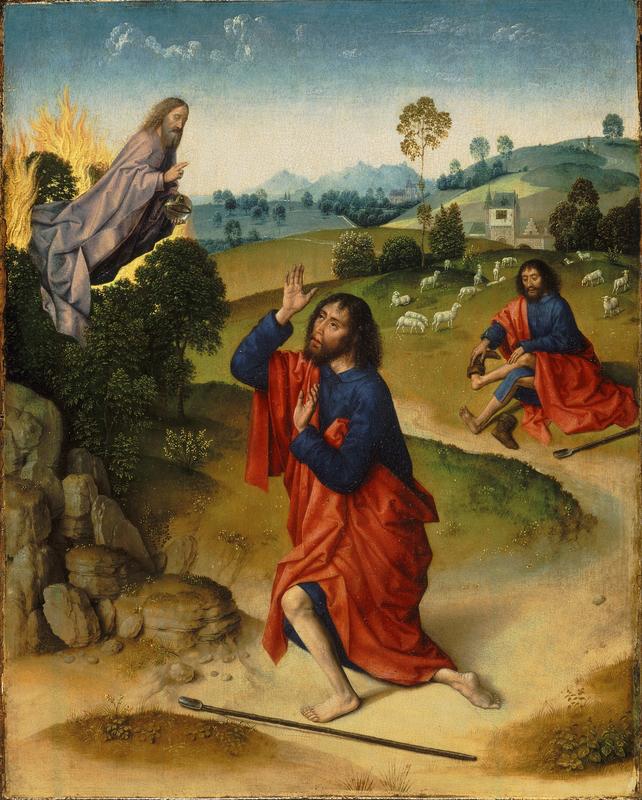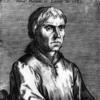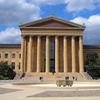More about Moses and the Burning Bush, with Moses Removing His Shoes

Contributor
Moses and the Burning Bush, with Moses Removing His Shoes, is almost unanimously attributed by researchers to Dierick "Dirk" Bouts the Elder, although Wolfgang Schöne, the "most extensive" cataloguer of Bouts works, attributes it to Dirk's son, Albrecht.
Like the Brueghel elders, Dirk Bouts passed his trade on to the next generation, and Schöne's attribution is partly due to the fact that Albrecht's work reads like a clone of his father's. If it ain't broke, Albrecht saw no reason to fix it.
As for the burning bush: Eastern Orthodox Christianity uses the better term "unburnt bush," and views it as a metaphor for the non-sexual pregnancy of Mary: the bush that burns without the fire consuming it, and the woman who gives birth without a man. In the Garden of Eden, the first humans had a perfectly good tree to eat from, the etz ha-daas, the Tree of Life, but we all know the end of that story. So why would the Divine Being appear to Moshe, A.K.A Moses, in a little shrub, the kind that desert businesses plant in their parking lots, plucky and close to the ground, rather than a tall, majestic tree? In the rabbinic tradition, it's because a low shrub is humble and relatively mundane, like Mount Sinai, where Moses received the Covenant—the Baal Shem Tov, for example, said that the "fire" represents spiritual knowledge, which satisfies, i.e., consumes, an educated person, and it is only the humble and uneducated who have an unending, and sacred, thirst for knowledge. Oddly enough, the bush grew in Egypt, the land of hard times—I guess that was the shot of spiritual caffeine the Israelites needed to keep on keepin' on.
When you watch the emotional roller coaster of the 24-hour news cycle, you'd think that Muslims, Jews, and Christians don't agree on anything, but, surprisingly, as with nearly all basic interpretations of the Torah, the three Abrahamic branches share similar interpretations of the two verses represented here by Bouts. All three agree, for example, that Bouts was exaggerating the verse by showing a white-haired man actually popping out of the bush at Moses. We could defend Bouts by saying that his painting appealed to illiterate people—in those days, the Arab world was more literate than Europe—and the image of the elderly man represents the Divine voice for folks who may not have read the original text.
Sources
- Conway, Sir William Martin. The Van Eycks and Their Followers. New York: Dutton, 1921.
- Geis, Robert. Life of Christ. New York: University Press of America, 2013.
- "Kann, Rodolphe." National Gallery of Art, https://www.nga.gov/collection/provenance-info.8549.html#biography.
- Mather, Frank Jewett, Jr. Magazine of Art 8. New York: American Federation of Arts, 1917.
- Meijers, Daniel. Ascetic Hasidism in Jerusalem: The Guardian-Of-The-Faithful Community of Mea Shearim. Leiden: Brill, 1992.
- Schöne, Wolfgang. Dieric Bouts und seine Schule: Mit 90 Bildtafeln, Volume 1. Berlin: Verlag für Kunstwissenschaft, 1938.
- Worcester Art Museum. European Paintings in the Collection of the Worcester Art Museum: Text. Worcester, MA: University of Massachusetts Press, 1974.












Whoops! I made a mistake: the Tree of Life is the Etz ha-Chayyim, not the Etz ha-Daas.